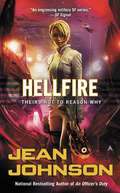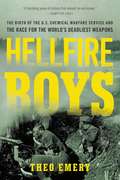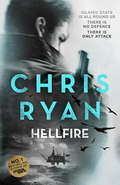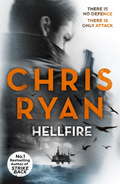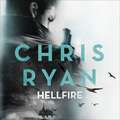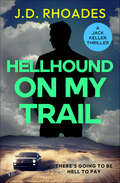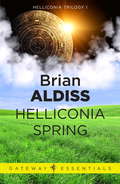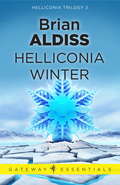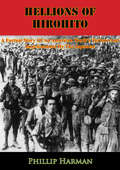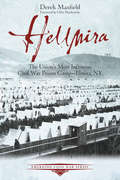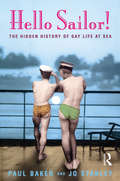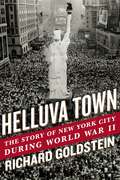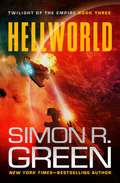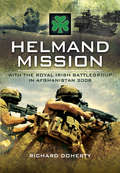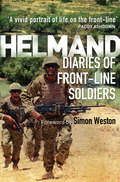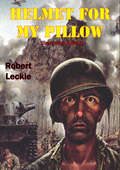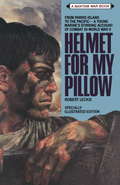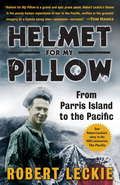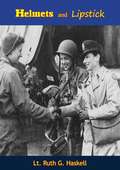- Table View
- List View
Hellfire (Theirs Not to Reason Why, Book #3)
by Jean JohnsonHer story began in the national bestsellers A Soldier's Duty and An Officer's Duty. Now Ia is captain and commander at the helm of Hellfire, where she is finally free to chart the course for the fulfillment of her destiny ... Ia must assemble a crew that can rise to the ultimate challenge of saving the galaxy. The hardest part will be getting them to believe her, to trust in her prophecies. If they don't, her own crew will end up being the biggest obstacle in her race against time. The Salik are breaking through the Blockade, plunging the known galaxy into war. Ia cannot stop it this time, nor does she want to. This is the terrible price she has seen all along--that some must pay with their lives so that others might live. Now only time itself can prove whether each member of her crew is merely a soldier or truly one of Ia's Damned.
Hellfire Boys: The Birth of the U.S. Chemical Warfare Service and the Race for the World¿s Deadliest Weapons
by Theo EmeryAn explosive look into the dawn of chemical warfare during World War I "A terrifying piece of history that almost no one knows." - Hampton Sides In 1915, when German forces executed the first successful gas attack of World War I, the world watched in horror as the boundaries of warfare were forever changed. Cries of barbarianism rang throughout Europe, yet Allied nations immediately jumped into the fray, kickstarting an arms race that would redefine a war already steeped in unimaginable horror. Largely forgotten in the confines of history, the development of the U.S. Chemical Warfare Service in 1917 left an indelible imprint on World War I. This small yet powerful division, along with the burgeoning Bureau of Mines, assembled research and military unites devoted solely to chemical weaponry, outfitting regiments with hastily made gas-resistant uniforms and recruiting scientists and engineers from around the world into the fight. As the threat of new gases and more destructive chemicals grew stronger, the chemists' secret work in the laboratories transformed into an explosive fusion of steel, science, and gas on the battlefield. Drawing from years of research, Theo Emery brilliantly shows how World War I quickly spiraled into a chemists' war, one led by the companies of young American engineers-turned-soldiers who would soon become known as the "Hellfire Boys." As gas attacks began to mark the heaviest and most devastating battles, these brave and brilliant men were on the front lines, racing against the clock-and the Germans-to protect, develop, and unleash the latest weapons of mass destruction.
Hellfire: Danny Black Thriller 3
by Chris RyanOn the Syria/Iraq border a British hostage is beheaded by IS terrorists. The executioner is a young British extremist. A masked figure watches him. This mysterious person is treated with a mixture of respect and terror. They call him the Caliph.In Nigeria the British High Commisioner and his young aide are kidnapped. A four-person SAS team, including Regiment hero Danny Black, is deployed to find him. The team find devastation in Nigeria, and when they discover prisoners infected with the plague they realise they have uncovered a combined Boko Haram/IS plot to unleash a bio-terror attack upon the world.The team must stop the terrorists and identify the Caliph before the deadly disease threatens those much closer to home.
Hellfire: Danny Black Thriller 3 (Danny Black #3)
by Chris RyanThe third book in the hugely popular Danny Black series by the creator of the hit TV show Strikeback.On the Syria/Iraq border a British hostage is beheaded by IS terrorists. The executioner is a young British extremist. A masked figure watches him. This mysterious person is treated with a mixture of respect and terror. They call him the Caliph.In Nigeria the British High Commisioner and his young aide are kidnapped. A four-person SAS team, including Regiment hero Danny Black, is deployed to find him. The team find devastation in Nigeria, and when they discover prisoners infected with the plague they realise they have uncovered a combined Boko Haram/IS plot to unleash a bio-terror attack upon the world.The team must stop the terrorists and identify the Caliph before the deadly disease threatens those much closer to home.
Hellfire: Danny Black Thriller 3 (Danny Black #3)
by Chris RyanOn the Syria/Iraq border a British hostage is beheaded by IS terrorists. The executioner is a young British extremist. A masked figure watches him. This mysterious person is treated with a mixture of respect and terror. They call him the Caliph.In Nigeria the British High Commisioner and his young aide are kidnapped. A four-person SAS team, including Regiment hero Danny Black, is deployed to find him. The team find devastation in Nigeria, and when they discover prisoners infected with the plague they realise they have uncovered a combined Boko Haram/IS plot to unleash a bio-terror attack upon the world.The team must stop the terrorists and identify the Caliph before the deadly disease threatens those much closer to home.(P)2015 Hodder & Stoughton
Hellhound on My Trail (The Jack Keller Thrillers)
by J.D. RhoadesBounty hunter Jack Keller thought he could leave the chaos behind—he was wrong. Fifth in the gritty thriller series from the author of Devils and Dust. Back in the desert, Jack Keller is trying to rebuild his life, piece by piece, and heal from the physical and emotional scars of the past. But trouble has a way of finding him. When Jack steps in to save a stranger from a brutal assault, he learns the man carries a message from the father who abandoned him—a message tied to the buried trauma Jack has carried since the first Gulf War. But his dying father has secrets of his own, and powerful enemies are determined to keep them hidden. At the center of the storm is a cunning and ruthless heiress to a political dynasty, willing to unleash any weapon to silence Jack—including an ex-government operative with a license to kill. Hunted and alone, Jack is forced to confront the darkness he&’s fought to keep at bay for years. As his demons surface, his rage threatens to destroy everything in its path. When the dust settles, there will be hell to pay—and no one will escape unscathed.Praise for J. D. Rhoades &“J. D. Rhoades writes action as well as anybody in the business, and bail bondsman Jack Keller is a winner.&” ―C. J. Box, #1 New York Times–bestselling author &“For fans of high-octane thrillers that don&’t ignore character development, Rhoades belongs on the same reading list with Stephen Hunter, Lee Child, and Randy Wayne White.&” —Booklist
Helliconia Spring (Gateway Essentials #325)
by Brian AldissThis is the first volume of the Helliconia Trilogy - a monumental saga which goes beyond anything yet created by this master among today's imaginative writers. An entire solar system is revealed, and with it a world disturbingly reflecting our own, Helliconia: an Earth-like planet where dynasties change with the seasons . Events and characters and animals stream across the pages of this gigantic novel. Cosmic in scope, it keeps an eye lovingly on the humans involved. So the 5,000 inhabitants of the Earth's observation station above Helliconia keep their eyes trained on the events of Oldorando and may long to intervene though the dangers are too great. So we on Earth have them all in our vision in one of the most consuming and magnificent novels of scientific romance.
Helliconia Spring (The\helliconia Trilogy Ser. #1)
by Brian AldissThis is the first volume of the Helliconia Trilogy - a monumental saga which goes beyond anything yet created by this master among today's imaginative writers. An entire solar system is revealed, and with it a world disturbingly reflecting our own, Helliconia: an Earth-like planet where dynasties change with the seasons . Events and characters and animals stream across the pages of this gigantic novel. Cosmic in scope, it keeps an eye lovingly on the humans involved. So the 5,000 inhabitants of the Earth's observation station above Helliconia keep their eyes trained on the events of Oldorando and may long to intervene though the dangers are too great. So we on Earth have them all in our vision in one of the most consuming and magnificent novels of scientific romance.
Helliconia Summer
by Brian AldissThe second novel in the epic Helliconia trilogy. It is the summer of the Great Year on Helliconia. The humans are involved with their own affairs. Their old enemies, the phagors, are comparitively docile at this time of year; yet they can afford to wait, to take advantage of human weakness - and of the king's weakness. How they do so brings to a climax this powerfully compelling novel, in which the tortuous unwindings of circumstance enmesh royalty and commoners alike, and involve the three Helliconia continents.
Helliconia Summer (Gateway Essentials #326)
by Brian AldissThe second novel in the epic Helliconia trilogy. It is the summer of the Great Year on Helliconia. The humans are involved with their own affairs. Their old enemies, the phagors, are comparitively docile at this time of year; yet they can afford to wait, to take advantage of human weakness - and of the king's weakness. How they do so brings to a climax this powerfully compelling novel, in which the tortuous unwindings of circumstance enmesh royalty and commoners alike, and involve the three Helliconia continents.
Helliconia Winter (Gateway Essentials #327)
by Brian AldissThe third and final book in the epic Helliconia trilogy. The centuries-long winter of the Great Year on Helliconia is upon us, and the Oligarch is taking harsh measures to ensure the survival of the people of the bleak Northern continent of Sibornal. Behind the battle with which the novel opens lies an act of unparalleled treachery. But the plague is coming on the wings of winter and the Oligarch's will is set against it - and against the phagors, humanity's ancient enemies, who carry the plague with them.
Helliconia Winter (The\helliconia Trilogy Ser. #3)
by Brian AldissThe third and final book in the epic Helliconia trilogy. The centuries-long winter of the Great Year on Helliconia is upon us, and the Oligarch is taking harsh measures to ensure the survival of the people of the bleak Northern continent of Sibornal. Behind the battle with which the novel opens lies an act of unparalleled treachery. But the plague is coming on the wings of winter and the Oligarch's will is set against it - and against the phagors, humanity's ancient enemies, who carry the plague with them.
Hellions Of Hirohito: A Factual Story Of An American Youth's Torture And Imprisonment By The Japanese
by Phillip HarmanThis is a factual story of a young American civilian imprisoned and tortured by the Japanese when they conquered Hong Kong. In a foreword by General Russell Hearn, who was instrumental in organizing the quasi-military Flying Tigers, there is an interesting personal reaction to the events described in the book in which he states for the record that "I believe there is no race of people on this earth quite as treacherous as the Japanese. Theirs is a treachery veiled by soft words and cunning smiles." Harman's account mostly mirrors this sentiment. The book itself dwells on the inadequacy of the Allied defense in Hong Kong, the brave efforts of the volunteers and civilians to hold the city, and the brutal acts committed by the victorious enemy against British and American civilians. Harman found himself stranded when the city fell, having worked for several years in the East on behalf of the United China Relief agency. Reporting on the beatings, the inadequate food, even the wanton incidents of Japanese soldiers raping women, he tells a story told before, including bouts of dysentery and afflictions of beri-beri while in captivity. Eventually, Harman describes his return to safety in America when he was exchanged for a Japanese national stranded in the United States.--Great Stories of World War II
Hellmira: The Union's Most Infamous Civil War Prison Camp—Elmira, NY (Emerging Civil War Series)
by Derek MaxfieldLong called by some the “Andersonville of the North,” the prisoner of war camp in Elmira, New York, is remembered as the most notorious of all Union-run POW camps. It existed for only a year—from the summer of 1864 to July 1865—but in that time, and for long after, it became darkly emblematic of man’s inhumanity to man. Confederate prisoners called it “Hellmira.” Hastily constructed, poorly planned, and overcrowded, prisoner of war camps North and South were dumping grounds for the refuse of war. An unfortunate necessity, both sides regarded the camps as temporary inconveniences—and distractions from the important task of winning the war. There was no need, they believed, to construct expensive shelters or provide better rations. They needed only to sustain life long enough for the war to be won. Victory would deliver prisoners from their conditions. As a result, conditions in the prisoner of war camps amounted to a great humanitarian crisis, the extent of which could hardly be understood even after the blood stopped flowing on the battlefields. In the years after the war, as Reconstruction became increasingly bitter, the North pointed to Camp Sumter—better known as the Andersonville POW camp in Americus, Georgia—as evidence of the cruelty and barbarity of the Confederacy. The South, in turn, cited the camp in Elmira as a place where Union authorities withheld adequate food and shelter and purposefully caused thousands to suffer in the bitter cold. This finger-pointing by both sides would go on for over a century. And as it did, the legend of Hellmira grew. In Hellmira: The Union’s Most Infamous POW Camp of the Civil War, Derek Maxfield contextualizes the rise of prison camps during the Civil War, explores the failed exchange of prisoners, and tells the tale of the creation and evolution of the prison camp in Elmira. In the end, Maxfield suggests that it is time to move on from the blame game and see prisoner of war camps—North and South—as a great humanitarian failure.
Hello Sailor!: The hidden history of gay life at sea
by Paul Baker Jo StanleyWhen gays had to be closeted, ships were the only places where homosexual men could not only be out but also camp. And on some liners to the sun and the New World, queens and butches had a ball. They sashayed and minced their way across the world's oceans. Never before has the story been told of the masses. These are the thousands of queer seafarers, mainly stewards, who sometimes even outnumbered the straight men in the catering departments of ships that were household names and the pride of the British fleet. Hello Sailor! uniquely shows what it was like to be queer at sea at a time when land meant straightness.
Helluva Town
by Richard GoldsteinIn the stirring signature number from the 1944 Broadway musical On the Town, three sailors on a 24-hour search for love in wartime Manhattan sing, "New York, New York, a helluva town." The Navy boys' race against time mirrored the very real frenzy in the city that played host to 3 million servicemen, then shipped them out from its magnificent port to an uncertain destiny. This was a time when soldiers and sailors on their final flings jammed the Times Square movie houses featuring lavish stage shows as well as the nightclubs like the Latin Quarter and the Copacabana; a time when bobby-soxers swooned at the Paramount over Frank Sinatra, a sexy, skinny substitute for the boys who had gone to war. Richard Goldstein's Helluva Town is a kaleidoscopic and compelling social history that captures the youthful electricity of wartime and recounts the important role New York played in the national war effort. This is a book that will prove irresistible to anyone who loves New York and its relentlessly fascinating saga. Wartime Broadway lives again in these pages through the plays of Lillian Hellman, Robert Sherwood, Maxwell Anderson, and John Steinbeck championing the democratic cause; Irving Berlin's This Is the Army and Moss Hart's Winged Victory with their all-servicemen casts; Rodgers and Hammerstein's Oklahoma! hailing American optimism; the Leonard Bernstein-Jerome Robbins production of On the Town; and the Stage Door Canteen. And these were the days when the Brooklyn Navy Yard turned out battleships and aircraft carriers, when troopships bound for Europe departed from the great Manhattan piers where glamorous ocean liners once docked, where the most beautiful liner of them all, the Normandie, caught fire and capsized during its conversion to a troopship. Here, too, is an unseen New York: physicists who fled Hitler's Europe spawning the atomic bomb, the FBI chasing after Nazi spies, the Navy enlisting the Mafia to safeguard the port against sabotage, British agents mounting a vast intelligence operation. This is the city that served as a magnet for European artists and intellectuals, whose creative presence contributed mightily to New York's boisterous cosmopolitanism. Long before 9/11, New York felt vulnerable to a foreign foe. Helluva Town recalls how 400,000 New Yorkers served as air-raid wardens while antiaircraft guns ringed the city in anticipation of a German bombing raid. Finally, this is the story of New York's emergence as the power and glory of the world stage in the wake of V-J Day, underlined when the newly created United Nations arose beside the East River, climaxing a storied chapter in the history of the world's greatest city.
Hellworld (Twilight of the Empire #3)
by Simon R. GreenSent to colonize a planet, a gang of outlaws fights to surviveA third-generation Naval officer, Scott Hunter was raised to be a captain in the Imperial starfleet. His career is soaring until he panics during a skirmish with the rebellion, a moment of weakness that gets half his crew killed. The Empire gives him a choice--quit the service, or join a Hell Squad.The Hell Squads are one-way planetary scouts--outcasts sent to explore new worlds and determine whether or not they are habitable. Their task is simple: either survive or die. For one whose whole life is the Navy, this was never a choice at all. On his first Hell Squad mission, Hunter leads a motley team of hard-nosed rebels to the volcano planet of Wolf IV. After a bumpy landing, they find that what was supposed to be a hospitable planet is actually completely barren. On a world that was meant to hold new life, why does there seem to be death all around?
Helmand Mission: With The Royal Irish Battlegroup in Afghanistan 2008
by Richard DohertyAfter celebrating St. Patricks Day 2008, 1st Royal Irish Battlegroup deployed to Afghanistans Helmand province as part of 16 Air Assault Brigade. For six months the Royal Irish fought the Taliban in Helmand in some of the most difficult country on earth. At the same time the Battlegroup was training the nascent Afghan National Army (ANA) and many of its engagements were alongside Afghan soldiers. Well trained and with an operational maturity gained from deployments in every year but one since 1998, they were considered the unit in 16 Air Assault Brigade best suited to the critical task of mentoring the ANA. One company deployed with 2 PARA Battlegroup in the Sangin valley. Its soldiers saw intense action against the Taliban, especially through the latters use of IEDs (Improvised Explosive Devices). Another company was given the task of ensuring the safe passage of an additional generator for the Kajaki dam and was involved in heavy fighting while so doing. TA soldiers from 2 R Irish formed Imjin Company which provided security but also deployed on wider tasks. Professionalism, high levels of trust and the unique humor of Irish soldiers ensured that they had a successful tour and accomplished their missions. This is the stirring story of a regimental family at war and of those who sustained them, including their remarkable chaplain, Padre Albert Jackson, and the rear party which supported the families, especially those whose fathers or sons suffered injury or death. Above all, it is the story of a highly professional unit demonstrating its skills to the world and helping make Afghanistan a better place for its people.
Helmand to the Himalayas: One Soldier's Inspirational Journey
by David Wiseman Nick HardingFramed around the horrific massacre of five British troops at a police station in Helmand province in 2009, Green On Blue: Helmand to the Himalayas tells the inspirational story of Captain David Wiseman, the first soldier on the scene after the events who was subsequently shot, badly injured but found salvation on the slopes of Mount Everest as one of Prince Harry's Mountain Heroes.This exhilarating memoir takes the reader on a gritty tour of Helmand Province with Captain Wiseman and his unit of infantrymen. Told with grit, he reveals what it was really like being one of the British Army's senior mentors to the Afghan National Army and recounts the horrors, humours and occasional absurdities of the conflict. For the first time he tells the story of the events of November 3rd, 2009 when a rogue Afghan police officer hijacked a unit of British soldiers as they rested in a police compound after a patrol. The 'green-on-blue' massacre remains the single biggest loss of life for British soldiers in the Afghan conflict and led to questions about the UK policy of cooperation and mentoring within Afghanistan and the reliability of the Afghan Police Force. The horrific scenes Captain Wiseman witnessed that day were to stay with him and alter the course of his life. Just a few weeks later, suffering from the early signs of PTSD, he was shot while on patrol and sustained life-changing injuries. The bullet that almost killed him is still lodged in his chest.The book tells the story of his recovery at Headley Court rehabilitation centre and the trauma of the PTSD which affected him following his tour of duty. With rare honesty, he tells of the hidden psychological injuries that remain after the physical wounds have healed. He recounts how frustration and chance led him to enlist to become one of an unlikely band of disabled ex-servicemen on a mission to climb Everest as part of the Walking With The Wounded charity. Against the odds, Captain Wiseman, who had no experience in climbing and a nerve injury which left him susceptible to intense pain sparked by temperature changes, was chosen to be in the summit team.With warmth and humour, the story details his training on some of the world's highest peaks and the friendships which were forged there. It exposes the crazy world of mountaineering, the parties on the peaks and culminates on the deadly slopes of the highest mountain in the world where Captain Wiseman discovers renewed purpose and pride.A cracking military chronicle, a dynamic adventure story and an inspirational memoir; Blue On Green: Helmand to the Himalayas takes the reader on a breath-taking ride across the world and details one man's journey from naive rookie, to broken vet, to hero.
Helmand: The Diaries of Front-line Soldiers
by Simon WestonA glimpse into life on the front line in Afghanistan told through the diaries of the British Marines During their tour of Afghanistan in 2008, a number of soldiers kept personal diaries of their experiences, and now, for the first time, Osprey Publishing has collected them together to provide a gripping first-hand account of life in the front line in modern warfare. Although these soldiers were on the same tour, they all encountered different experiences, and so while the time frame is the same, their perspectives are inevitably different. Included here are the diaries of Lt John Thornton, who sadly lost his life just two weeks before the end of the tour, a Padre, a CO, a 2IC, and a member of Lt Thornton's section. The diary of Lt Thornton's brother, Ian, who returned from Helmand in 2012, provides an example of the war four years later and provides further context to the original tour diaries.With an introduction that pulls the diaries together and puts them in context, this book provides a chance to look at what changes when the men and women come home, and what they learned from the tour.
Helmet For My Pillow [Illustrated Edition]
by Robert LeckieIncludes over 220 photos, maps and plans following Robert "Lucky" Leckie's Pacific War with the 1st Marine Division"Here is one of the most riveting first-person accounts ever to come out of World War II. Robert Leckie enlisted in the United States Marine Corps in January 1942, shortly after the Japanese attack on Pearl Harbor. In Helmet for My Pillow we follow his odyssey, from basic training on Parris Island, South Carolina, all the way to the raging battles in the Pacific, where some of the war's fiercest fighting took place. Recounting his service with the 1st Marine Division and the brutal action on Guadalcanal, New Britain, and Peleliu, Leckie spares no detail of the horrors and sacrifices of war, painting an unvarnished portrait of how real warriors are made, fight, and often die in the defense of their country. From the live-for-today rowdiness of marines on leave to the terrors of jungle warfare against an enemy determined to fight to the last man, Leckie describes what war is really like when victory can only be measured inch by bloody inch. Woven throughout are Leckie's hard-won, eloquent, and thoroughly unsentimental meditations on the meaning of war and why we fight. Unparalleled in its immediacy and accuracy, Helmet for My Pillow will leave no reader untouched. This is a book that brings you as close to the mud, the blood, and the experience of war as it is safe to come."-Print Ed.
Helmet for My Pillow
by Robert LeckieHere is one of the most riveting first-person accounts ever to come out of World War II. Robert Leckie enlisted in the United States Marine Corps in January 1942, shortly after the Japanese attack on Pearl Harbor. In Helmet for My Pillow we follow his odyssey, from basic training on Parris Island, South Carolina, all the way to the raging battles in the Pacific, where some of the war's fiercest fighting took place. Recounting his service with the 1st Marine Division and the brutal action on Guadalcanal, New Britain, and Peleliu, Leckie spares no detail of the horrors and sacrifices of war, painting an unvarnished portrait of how real warriors are made, fight, and often die in the defense of their country. From the live-for-today rowdiness of marines on leave to the terrors of jungle warfare against an enemy determined to fight to the last man, Leckie describes what war is really like when victory can only be measured inch by bloody inch. Woven throughout are Leckie's hard-won, eloquent, and thoroughly unsentimental meditations on the meaning of war and why we fight. Unparalleled in its immediacy and accuracy, Helmet for My Pillow will leave no reader untouched. This is a book that brings you as close to the mud, the blood, and the experience of war as it is safe to come.Now producers Tom Hanks, Steven Spielberg, and Gary Goetzman, the men behind Band of Brothers, have adapted material from Helmet for My Pillow for HBO's epic miniseries The Pacific, which will thrill and edify a whole new generation.From the Trade Paperback edition.
Helmet for My Pillow: From Parris Island to the Pacific
by Robert LeckieHere is one of the most riveting first-person accounts ever to come out of World War II. Robert Leckie enlisted in the United States Marine Corps in January 1942, shortly after the Japanese attack on Pearl Harbor. In Helmet for My Pillow we follow his odyssey, from basic training on Parris Island, South Carolina, all the way to the raging battles in the Pacific, where some of the war's fiercest fighting took place. Recounting his service with the 1st Marine Division and the brutal action on Guadalcanal, New Britain, and Peleliu, Leckie spares no detail of the horrors and sacrifices of war, painting an unvarnished portrait of how real warriors are made, fight, and often die in the defense of their country. From the live-for-today rowdiness of marines on leave to the terrors of jungle warfare against an enemy determined to fight to the last man, Leckie describes what war is really like when victory can only be measured inch by bloody inch. Woven throughout are Leckie's hard-won, eloquent, and thoroughly unsentimental meditations on the meaning of war and why we fight. Unparalleled in its immediacy and accuracy, Helmet for My Pillow will leave no reader untouched. This is a book that brings you as close to the mud, the blood, and the experience of war as it is safe to come. Now producers Tom Hanks, Steven Spielberg, and Gary Goetzman, the men behind Band of Brothers, have adapted material from Helmet for My Pillow for HBO's epic miniseries The Pacific, which will thrill and edify a whole new generation.
Helmet for My Pillow: From Parris Island to the Pacific
by Robert LeckieHere is one of the most riveting first-person accounts ever to come out of World War II. Robert Leckie enlisted in the United States Marine Corps in January 1942, shortly after the Japanese attack on Pearl Harbor. In Helmet for My Pillow we follow his odyssey, from basic training on Parris Island, South Carolina, all the way to the raging battles in the Pacific, where some of the war's fiercest fighting took place. Recounting his service with the 1st Marine Division and the brutal action on Guadalcanal, New Britain, and Peleliu, Leckie spares no detail of the horrors and sacrifices of war, painting an unvarnished portrait of how real warriors are made, fight, and often die in the defense of their country. From the live-for-today rowdiness of marines on leave to the terrors of jungle warfare against an enemy determined to fight to the last man, Leckie describes what war is really like when victory can only be measured inch by bloody inch. Woven throughout are Leckie's hard-won, eloquent, and thoroughly unsentimental meditations on the meaning of war and why we fight. Unparalleled in its immediacy and accuracy, Helmet for My Pillow will leave no reader untouched. This is a book that brings you as close to the mud, the blood, and the experience of war as it is safe to come.Now producers Tom Hanks, Steven Spielberg, and Gary Goetzman, the men behind Band of Brothers, have adapted material from Helmet for My Pillow for HBO's epic miniseries The Pacific, which will thrill and edify a whole new generation.From the Trade Paperback edition.
Helmets and Lipstick
by Lt. Ruth G. HaskellFirst published in 1944, this is a true firsthand account by U.S. Army nurse Ruth G. Haskell, 2nd Lieutenant A.N.C. (Army Nurse Corps), who worked on the North African front during World War II. She tells of the “trials and tribulations, the fun and the thrills” that she experienced as a member of the Corps.
